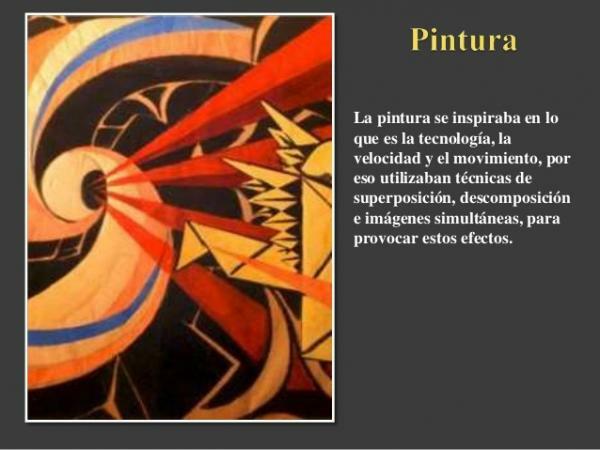6 characteristics of FUTURISTIC PAINTING

In 1909 Futurism burst into force with the publication of his Manifest on the front page of the French newspaper Le Figaro. The Futurist manifesto, signed by the poet Filippo Tommaso MarinettiIn his quest for progress and modernity, he chose to make himself known in the mass media and launched an absolutely disruptive message with the past. Marinetti lashed out at the veneration for the classical Italian cultural tradition, the so-called passatism, and invited the destruction of museums and libraries, as well as of movements such as feminism. From that first manifesto, Futurism quickly became an international movement, extending to all fields of art: painting, sculpture, architecture, music, photography, cinema and al fashion design.
In this lesson from unPROFESOR.com we bring you closer to characteristics of futuristic painting, the art of progress, dynamism, speed and technology.
Index
- Exaltation of industrial development, one of the characteristics of Futurism
- Break with classic Italian culture
- A great political implication
- Publication of your manifestos in the press
- Representation of movement or dynamism
- Artistic Techniques of Futurism
- Influenced other avant-garde movements
Exaltation of industrial development, one of the characteristics of Futurism.
"A racing car with its hood adorned with thick tubes resembling snakes of breath explosive... a roaring car that seems to run on shrapnel, is more beautiful than the Victory of Samothrace ”.
(Filippo Tommaso Marinetti: "Foundation and manifesto of Futurism", in Le Figaro, February 20, 1909.
With this phrase from the Futurist Manifesto, Marinetti, leader of the Futurism, celebrate the "Era of machines", progress and modernity. A celebration that led futurist painters to seek the recreation of their vision of the future, a unique and dynamic vision that leads them to represent urban landscapes, as well as converting the exciting new technological advancements into protagonists: electricity, X-rays, radio waves, trains, automobiles and airplanes become protagonists.
Futurists glorify speed, violence, and the working classes in their works, expanding their influence to literature, theater, music, and even gastronomy. The aesthetics of the speed, movement, energy, vitality and industrial development it will flood all futuristic works of art.
Break with classic Italian culture.
“It is from Italy that we launched to the world this our manifesto of overwhelming and incendiary violence with which we founded today futurism because we want to free this country from its fetid gangrene of teachers, archaeologists, cicerones and antiquarian."
Another characteristic of Futurist painting is that they broke with classical culture. For the futurists, the Italian classical, renaissance and baroque art and culture represented the past, leaving the whole of Italy under the stigma of the antiquated, the old-fashioned and locating the country lagging behind Great Britain, France, Germany and the United States in the pace of its development industrial.
This idea generated enormous frustration in the Futurists who believed that the decline of Italy places them outside the world order. To combat the lethargy and backwardness prevailing in their country, Italian writers and artists rose up in fury to celebrate the "Era of machines."

Image: Slideshare
A great political implication.
Futurism was one of the most politicized art movements of the vanguards. The desire to drive change toward industrial progress led to a fusion of the political and cultural agenda. In the futuristic serate or futuristic evenings artists recited poetry and displayed their works of art, while also politically agitating their audience in their belief that upheaval and destruction would put an end to the status quo and allow the regeneration of a more strong.
These ideas led the Futurists to support entry into the First World War, with the majority of the group's members participating in it. After the war, the intense nationalism of members led to an alliance with Benito Mussolini and his National Fascist Party. Many Italian Futurists supported fascism and when Mussolini took power in 1922 the movement received an official recognition of Futurism. The defeat of fascism negatively affected many of the artists, disowned for their association.

Publication of your manifestos in the press.
The Futurists published large number of different manifests to get their aesthetic, political and social ideals to the public. Although the realists and the Symbolists had already done something similar, the scale with which the Futurists created and disseminated their manifestos was unprecedented. This helped them convey their ideas to a wider audience, using all the advancements in media, print and transportation for distribution.
Futurist painters, among whom were Umberto Boccioni, Carlo Carrà, Luigi Russolo, Gino Severini and Giacomo Balla, signed their first manifesto in 1910.
Representation of movement or dynamism.
Futurists were enthusiastic about the works of Étienne-Jules Marey, scientist and photographer of the late nineteenth century. His studies chronophotographic (based on time) described the mechanics of animal and human movement.
The cinema and innovative experiments of Marey were especially influential in the work of the painter Giocomo Balla. In his painting Dynamism of a dog on a leash, the artist interprets the dog's feet as continuous movements through space in time.

Artistic Techniques of Futurism.
We finish this review of the Characteristics of Futurist painting by talking about the main techniques used by these artists. They were the following:
Repetition and use of lines of force
The group of Futurist painters used the blur, repeat, and use of force linesa as novel techniques to express speed and movement. The lines of force were adapted from the work of the Cubists, being one of the characteristics of the Futurist images.
Dividing shapes into dots and lines and motion blur
Another element was borrowed from the methods of the neo-impressionism, especially from divisionism. Thus, for example, they adopted the division of shapes into dots and lines capable of representing the brightness of light or the blurring of high-speed motion. A technique they borrowed from Italian Divisionism and the paintings of Vittore Grubicy De Dragon (1851-1920).
Optical experiments
Futurist painting had for the first time employed the color and optical experiments employed in late 19th century painting. Following the visit of Marinetti and the Futurist painters in the fall of 1911 to the Paris Autumn Salon to see Cubism in person for the first time, they fell under the influence of analytical cubism and adopted techniques such as fragmented forms, multiple points of view and the use of very marked diagonals.
It influenced other avant-garde movements.
Futurism, invented and directed from Italy by the charismatic poet Marinetti, was an influential and active movement between 1909 and 1914. After World War I, Marinetti got it back on track by attracting new artists and becoming known as second-generation Futurism.
Futuristic ideas were used by artists in Great Britain, calling themselves there vorticism, the United States and Japan, with futuristic works exhibited throughout Europe. The Russian futurism it is generally considered a distinct movement, although some Russian Futurists traced its origins to the Italian movement of 1909. Futurism anticipated the aesthetics of Art deco and influenced the Dadaism and the german expressionism.
If you want to read more articles similar to Characteristics of futuristic painting, we recommend that you enter our category of Story.
Bibliography
- Aurrekoetxea, Aitor (2019). Futurism and fascism. Aesthetics and poetics of modernity (1909-1922). Comares
- Gualdoni, Flaminio (2008). Futurism. Skira



